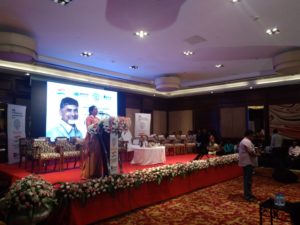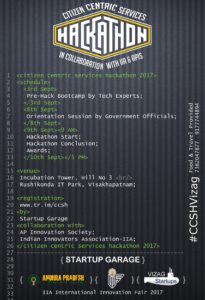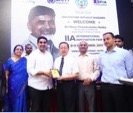Summary of the PROCEEDINGS OF IIIF2017
9th – 11th SEPTEMBER 2017, Taj Gateway, Visakhapatnam
This India International Innovation Fair was hosted by Government of Andhra Pradesh through AP Innovation Society. IFIA- International Federation of Inventors Association has supported it through connecting us with Innovators Associations in around 100 countries across the world. The Fair has attracted 75 participants from 30 countries other than India. In all we had 300 delegates from within India and more than 5000 visitors for the stalls.
In addition to IFIA, APCTT of ESCAP has conducted a workshop in parallel to the Fair.
IIIF 2017 is an event planned to outreach innovators from a wide spectrum of domains and capabilities varying from schools to colleges to researchers in institutes and organisations to inventors from villages and startups.
The session started with CEO, AP Innovation Society welcoming the guests.

IIA was the local partner for APIS for organising the event. It’s President Dr A.S.Rao, announced the agenda and said this initiative would help create employment through creating new enterprises. .Mr Krishnan Srinivasa Raghavan, APCTT described the role of their UN body stressing that promoting innovation is as important as creating innovation.
Highlights: The Visakhapatnam event was announced globally in 100 countries by global networks- IFIA and APCTT of ESCAP. Global participation of 75 from 30 countries. 300 innovations exhibited. Wide range of participation from school children (Young scientists), grass root innovators, engineering students and startups. International workshop held by UN Organization- APCTT of ESCAP, first time in partnership with a state government. CCS Hackathon organized as parallel event. Awareness and excitement created in the state on Innovations. 5000 visitors in 3 days. Visakhapatnam and Andhra Pradesh are now on radar of global innovation networks.
 The event was inaugurated by IFIA President, Alireza Rastegar. He also released the NCSTC magazine containing articles published by young scientists.
The event was inaugurated by IFIA President, Alireza Rastegar. He also released the NCSTC magazine containing articles published by young scientists.
 Around 600 registrations were done, of which 300 were filtered for hackathon from around 40 colleges. District Collector, Sri Praveen Kumar was kind enough to grace the inaugural. Jury from NIC and ITAAP helped in judging the best solutions. The local Vizag startups community partnered with us to conduct the event.
Around 600 registrations were done, of which 300 were filtered for hackathon from around 40 colleges. District Collector, Sri Praveen Kumar was kind enough to grace the inaugural. Jury from NIC and ITAAP helped in judging the best solutions. The local Vizag startups community partnered with us to conduct the event. There were around 200 participants from educational institutions, research and development institutions, small and medium enterprises, grass root innovators and entrepreneurs. This workshop also had international participants including senior representatives from APCTT’s partner, organisations in India, Indonesia, Islamic Republic of Iran, Kazakhstan countries in Middle-East, Europe and Philippines. The aim is to boost awareness on the support mechanisms available for innovative entrepreneurs and share finest practices in cross border technology transfer from countries in the Asia Pacific region and beyond. It also focused on opportunities and challenges for technology commercialization, effective management of intellectual property rights, establishing and sustaining cross-border cooperation on technology transfer and sharing policy frameworks for technology transfer and innovation led entrepreneurship.
There were around 200 participants from educational institutions, research and development institutions, small and medium enterprises, grass root innovators and entrepreneurs. This workshop also had international participants including senior representatives from APCTT’s partner, organisations in India, Indonesia, Islamic Republic of Iran, Kazakhstan countries in Middle-East, Europe and Philippines. The aim is to boost awareness on the support mechanisms available for innovative entrepreneurs and share finest practices in cross border technology transfer from countries in the Asia Pacific region and beyond. It also focused on opportunities and challenges for technology commercialization, effective management of intellectual property rights, establishing and sustaining cross-border cooperation on technology transfer and sharing policy frameworks for technology transfer and innovation led entrepreneurship. Minister for ITE&C , Mr Nara Lokesh released the Inaugural issue of International Technology Bazar along with catalogue of the fair, on 9th evening.
Minister for ITE&C , Mr Nara Lokesh released the Inaugural issue of International Technology Bazar along with catalogue of the fair, on 9th evening.